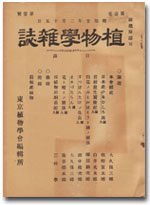All issues

Volume 42, Issue 503
Displaying 1-8 of 8 articles from this issue
- |<
- <
- 1
- >
- >|
-
Naohide Hiratsuka1928 Volume 42 Issue 503 Pages 503-504
Published: 1928
Released on J-STAGE: January 26, 2011
JOURNAL FREE ACCESSDownload PDF (196K) -
T. Sugiura1928 Volume 42 Issue 503 Pages 504-506
Published: 1928
Released on J-STAGE: January 26, 2011
JOURNAL FREE ACCESSDownload PDF (279K) -
M. Honda1928 Volume 42 Issue 503 Pages 506-509
Published: 1928
Released on J-STAGE: January 26, 2011
JOURNAL FREE ACCESSDownload PDF (474K) -
I. NISHIYAMA1928 Volume 42 Issue 503 Pages 509-513
Published: 1928
Released on J-STAGE: January 26, 2011
JOURNAL FREE ACCESSChromosome numbers of two species of the genus Lycoris have been determined as follows:
Number of chromosomes in the heteorotypic metaphase. Somatic number.
L. sanguinea, MAXIM. 11II (Fig. lb) 22 (Fig. lc)
L. radiata, HERB. 11III (Fig. 2b) 33 (Fig. 2d)
From these results it is clear that L. radiata is a triploid species.
Fig. 3. shows heterotypic division in the pollen mother-cells disturbed their chromosome behavior by environmental conditions, probably high temperature; in Fig. 3a 33 unpaired chromosomes are shown. Cytological investigations show that the complete sterility of L. radiatais mainly caused by irregular meiotic divisions.View full abstractDownload PDF (573K) -
K. OHKI1928 Volume 42 Issue 503 Pages 514-524
Published: 1928
Released on J-STAGE: January 26, 2011
JOURNAL FREE ACCESSDownload PDF (1122K) -
TOMOWO ONO1928 Volume 42 Issue 503 Pages 524-533
Published: 1928
Released on J-STAGE: January 26, 2011
JOURNAL FREE ACCESSI. The development of the embryosac and embryo of R. Acetosa.
The formation of embryosac of R. Acetosa proceeds quite normally. In the diakinesis and the heterotypic metaphase of megaspore mother cells, seven gemini are seen. One of them is much larger than the others and is considered to be the pair of X-chromosomes. After the reducing division, four usual megaspores are formed. The innermost one among them is functional and forms later an 8-nucleate normal embryosac. The double fertilization occurs in the usual manner. The development of fertilized eggs is quite normal. Two different types of embryo, namely with 14 and 15 chromosomes, have been observed.
II. The occurrence of the triploid female of R. Acetosa.
Triploid, 22-chromosomal intersexual plants were described in my previous paper. During the examination of the somatic chromosomes of a number of wild female plants, one 21-chromosomal, triploid female has been found. The chromosomal formula of this plant should be perhaps as follows; 21=18+3X=_??_(12+2X)+_??_(6+X).
III. Reducing division of the triploid intersexual plant of R. Acetosa.
The meiosis of the intersexual plants of R. Acetosa proceeds not quite normally, especially in the potted plants. The material obtained from a plant growing wild has shown, however, comparatively good figures. The number of chromosomes in.somatic cell of that plant has been determined to be 22(=18+2X+2Y). In the early metaphase of the heterotypic nuclear division of pollen mother cells, there appear six trivalents, one large ring-shaped XX-pair and two separated Y-elements. The division of these chromosomal elements shows some irregularities but they are distributed by chance almost equally in number to the opposite poles. After the abnormal second division four abortive pollens are formed.
IV. Diploid nuclear plates in pollen mother cells of R. Acetosa.
In the materials fixed in the early spring of this year, nuclear plates with unreduced number (viz. 15) are often observed among the normal ones during the heterotypic nuclear division of the pollen mother cells. These 15 chromosomes are split normally in the anaphase. The formation of these diploid chromosomal gamates may be related to the origin of the triploid and tetraploid plants often found in the fields.
V. Chromosomes of R. vesicarius.
R. vesicarius is an annual hermaphrodite plant, belonging to subgenus Acetosa. The diploid and haploid numbers of chromosomes of this plant are 18 and 9 respectively. The basal number 9 in the genus Rumex had not previously been found in the subgenus Acetosa, nor in the subgenus Lapathum.
The haploid number of chromosomes of Oxylia elatior has also been determined to be 7 in the reducing division of pollen mother cells.View full abstractDownload PDF (1421K) -
1928 Volume 42 Issue 503 Pages 533-544
Published: 1928
Released on J-STAGE: January 26, 2011
JOURNAL FREE ACCESSDownload PDF (3898K) -
1928 Volume 42 Issue 503 Pages 545-546
Published: 1928
Released on J-STAGE: February 23, 2022
JOURNAL FREE ACCESSDownload PDF (255K)
- |<
- <
- 1
- >
- >|